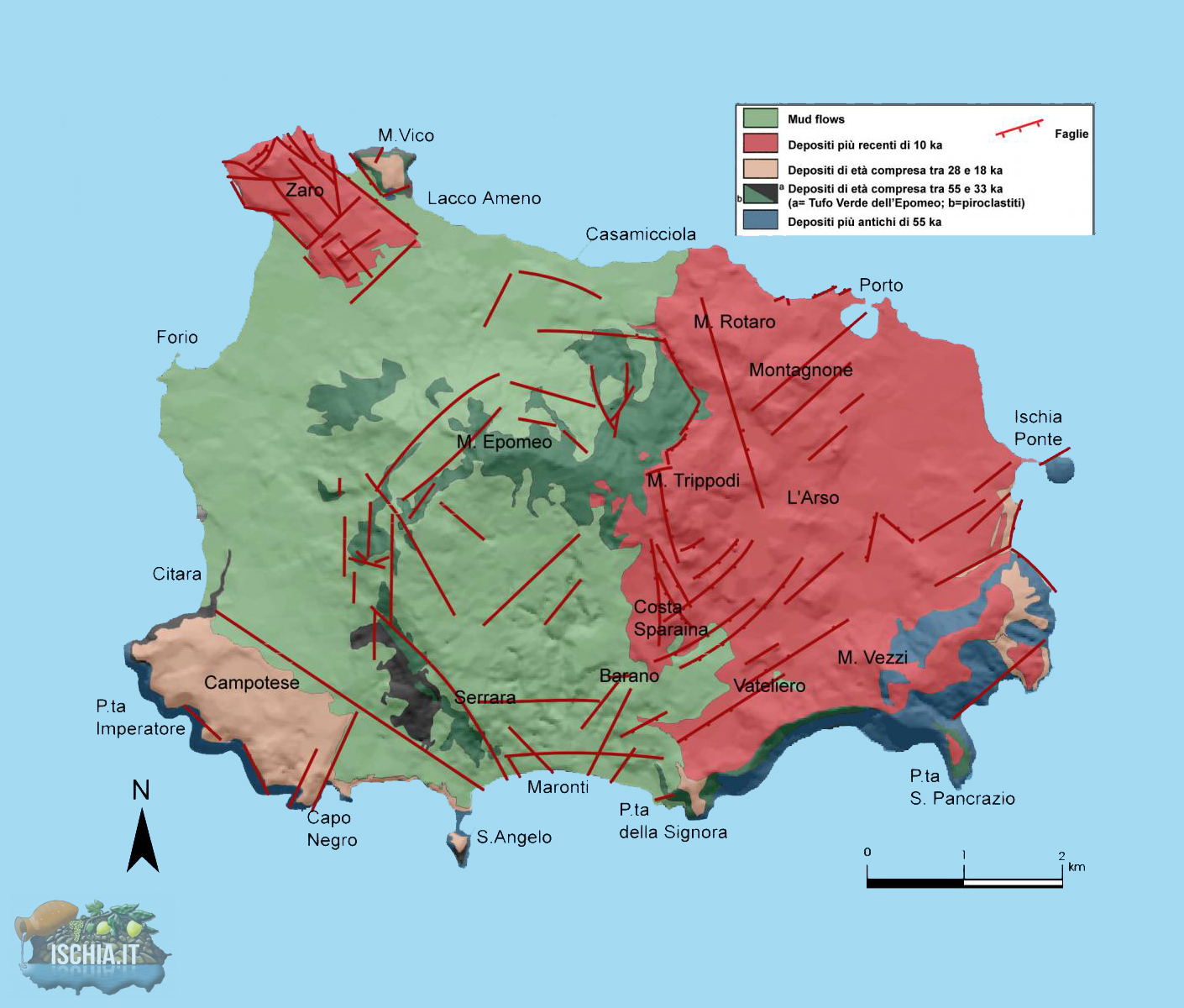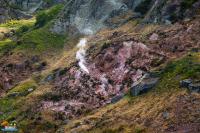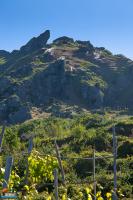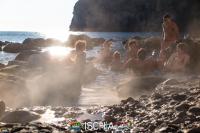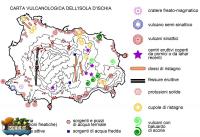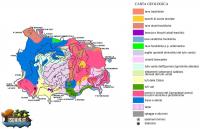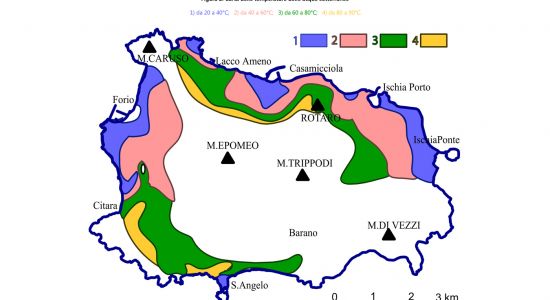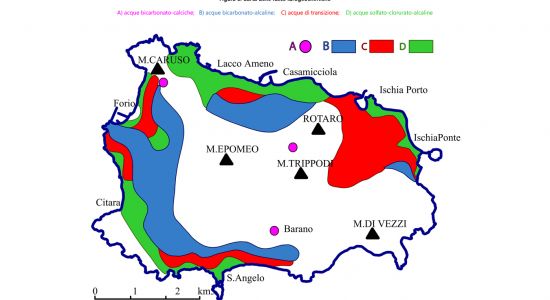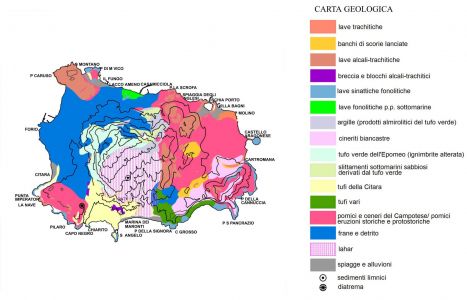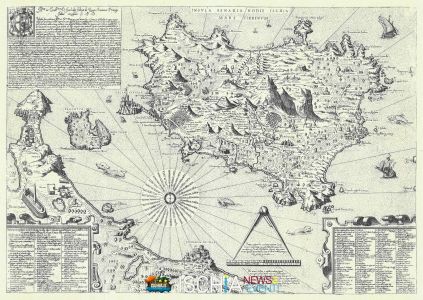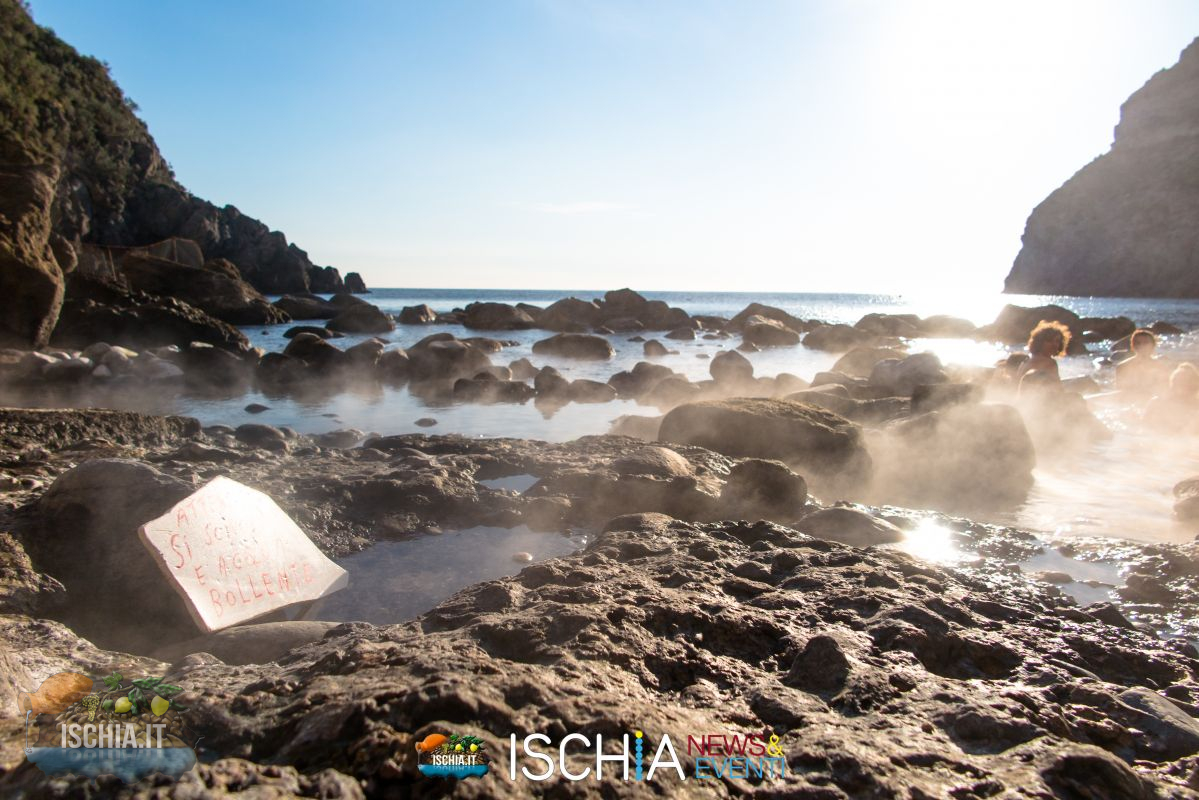The 1301 eruption, which originated the trachytic flow from the Arso, was the last one to ever happen on the Island. However, the differential bradyseisms, the earthquakes and the exhalent -hydrothermal manifestations in particular, show that the magmatic field on Ischia is still active.
There are 29 thermal spring groups distributed on the island territory, from which 103 springs and 69 fumarolic groups spout. The latter forms a manifestation that is strictly linked to the previous one since it is produced by the evaporation from the thermal table.
It can be stated that wherever exhalant phenomena are present there are thermal waters in the subsoil. The link between the two types of manifestations is obvious since they both originate from the same thermal table. Areas with fumarolic fields and hydrothermal springs are distributed more or less along the whole area behind the coastline, particularly in Maronti and near the town centres of Ischia, Casamicciola, Lacco Ameno and Forio. Further concentrations can be found in the internal area along the western border of Epomeo and the hinterland of Barano and Panza. It is noted that all the fumarolic and hydrothermal groups can be found along the volcanic-tectonic lines or in correspondence of ancient crateral vents.
If it is considered that the table temperature, the level of permeability (to vapour and water) of the complex of terranes where the table is placed, and the ones overlooking the same, influence the vaporous manifestations originating from a water table and their characteristics, , it can be seen how, basically,
the manifestations take place where there are tectonic peculiarities (faults, fractures) or structural peculiarities of the subsoil (lava flows etc.); in other words, where there are areas of relatively higher permeability.
In the communes of Forio and Lacco Ameno the fumarolic groups of Casa Verde, Roccia della Frana, Montagna Nuova and Portella Bianca are in correspondence of the crateral edge of Mount Nuovo. Similarly, in the commune of Lacco Ameno the groups of Mount Vico, Mount Tabor, Mount Rotaro and Citrunia (Forio Campotese) are in correspondence of the crateral edges of Mount Vico, Mounts Rotaro, Tabor and Imperatore. The groups of Bocca, Bellomo, Vagnulo, Schiappa di Montecorvo , in the Forio territory, are relative to the faults system (non-spontaneous fractures) determining the western side of the Epomeo massif. The groups of Cava Fasaniello, Mount Cito, Mount di Mezzo, Fasano, Bianchetto and Regione Cratica (Casamicciola) are, in turn, relative to the fault system determining the northern side of the same Epomeo. However, other groups exist where no tectonic peculiarities are noticed such as in Lacco Ameno, Cava di Succhivo etc. The subterranean hydrology of a volcanic region such as Ischia, where formations of various levels of permeability alternate in all directions and at brief intervals, is very complex and varies from one area to another.
The various combinations of exogenous and marine infiltrated waters with magmatic-endogenous waters (presence of radon and thoria as well as other elements), which are the essential prerogative of the thermal waters on Ischia, derive from this outline. Waters that are all considered to be the most radioactive in Europe. Moreover, their chemical composition varies according to the nature of the terrane. One can distinguish between chloride-sodium waters with about 75 springs in the territories of Ischia Porto, Lacco Ameno and Casamicciola, and bicarbonate-alkaline waters with about 20 springs in Casamicciola and Barano.
The difference in composition and temperature allows for various clinical applications and the current thermal establishments definitely possess a therapeutic specialization in relation to the different qualities of the waters and are consumed on a national and international level. Even from the brief above-mentioned notes, it can be seen that through the nature, the quality and quantity of the hydrothermal resources on Ischia, the transformations that have concerned the Island can be interpreted through the particular characteristics assumed by tourist development with the establishment of curative thermalism. Known since ancient times and relaunched during the nineteenth century among the elite, the activities connected to the exploitation of hydrothermal resources have recently become a decisive factor in the Island's economic, social and settlement transformation.
In particular, it was during the sixties that the tourist industry was identified as a valid alternative to the old agricultural economy, which was in a regressive phase, as well as the new strong point of local development. Consequently, the monoculture of thermalism gradually substituted that of vineyard cultivation. The first tourist incentives launched on a national and international level were focused in Lacco Ameno and Ischia Porto where large thermal centres, residential hotels and thermal parks based on the principle of open air thermalism were created. Soon, the process extended to the western and southern side of the Island, in coastal areas with a high panoramic quotient and entrepreneurial activities aimed at satisfying the needs of the masses continued to increase.
The success of seaside tourism in answer to parallel needs along with the tremendous development of holiday houses and development building in general, interwoven with the expansion of thermalism, contributed to activate consistent and widespread processes of territory consumption that can easily be seen in the settling, landscape and environmental structure; a structure that runs the risk of turning the Island into an immense anonymous periphery.
Therefore, if it is true that tourism represents an important and indisputable factor for Ischia's economic and social wellbeing, it is also true that due to its specific characteristics, it is having a considerable effect on the territorial context where it takes place.
In fact, it generates an unrestrainable transformation process, which tends to cancel any diversity and makes for a banal and stereotyped environment, inclined to reproducing urban conditions. It can even be said that banalisation, that is, the loss of specificness and environmental qualities, which is afflicting the Island is a direct effect, on a systemic level, of a particular type of "pollution": that produced by a type of tourism which is becoming more and more standardized and invasive, risking the destruction of the same resources that determined its presence on the territory in the first place, therefore ultimately risking its own destruction.


